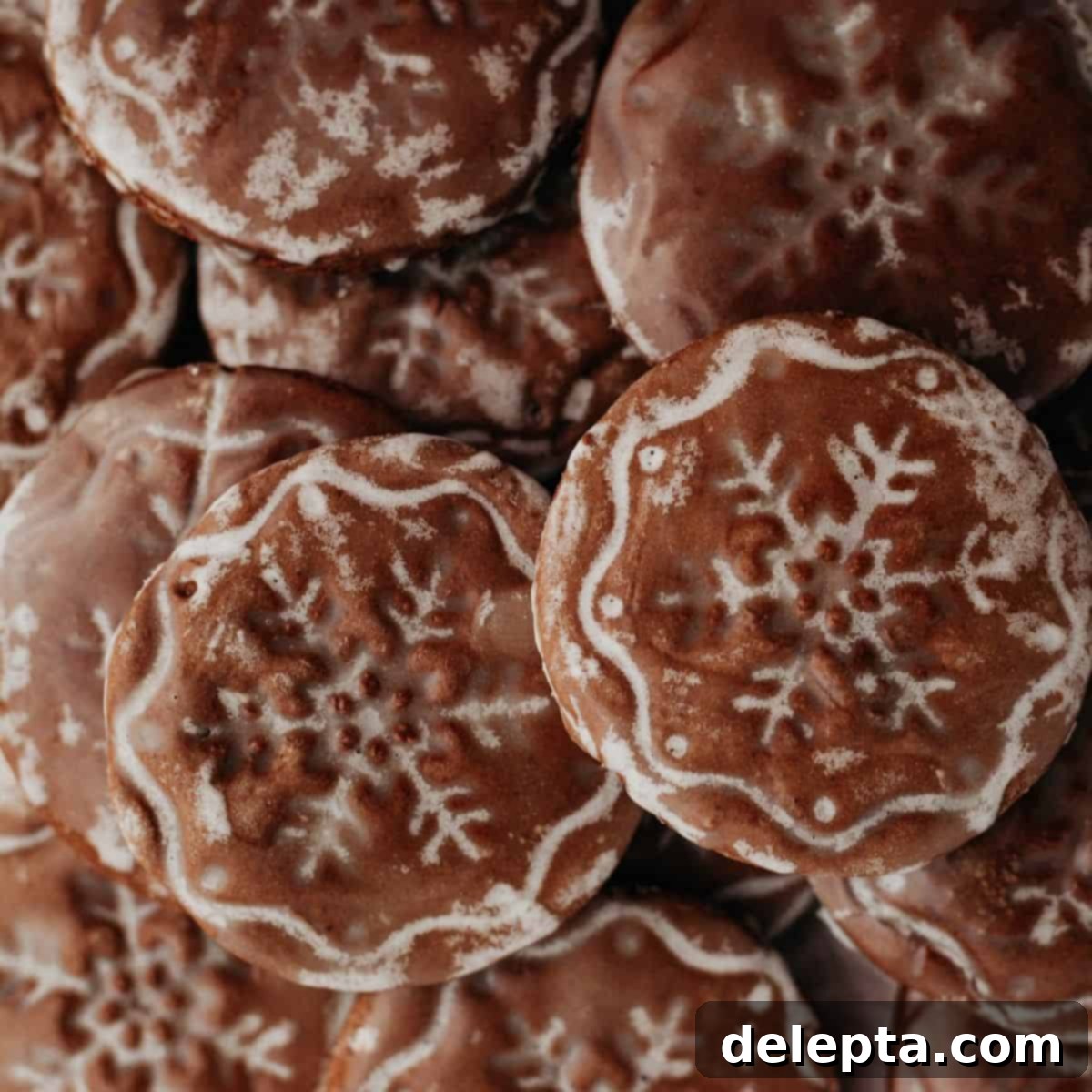Authentic German Gingerbread Cookies (Lebkuchen) with a Festive Glaze | Perfect for Holiday Baking
Experience the magic of European Christmas markets right in your kitchen with these authentic German gingerbread cookies, also known as Lebkuchen! These delightful treats are crafted with a perfect blend of warm, inviting spices and a hint of cocoa powder for a subtle chocolate kick that’s utterly irresistible during the festive season. Each cookie is beautifully stamped, then finished with a simple, elegant glaze, making them a stunning addition to any holiday party spread or a cozy afternoon tea. If you’ve ever wandered through the twinkling lights of a German or Swiss Christmas market, you’ll recognize the comforting aroma and rich flavor of these soft, spiced cookies. Growing up in Switzerland, enjoying a lebkuchen (or a delightful variation) was a beloved winter tradition, a taste I’m thrilled to share with you!
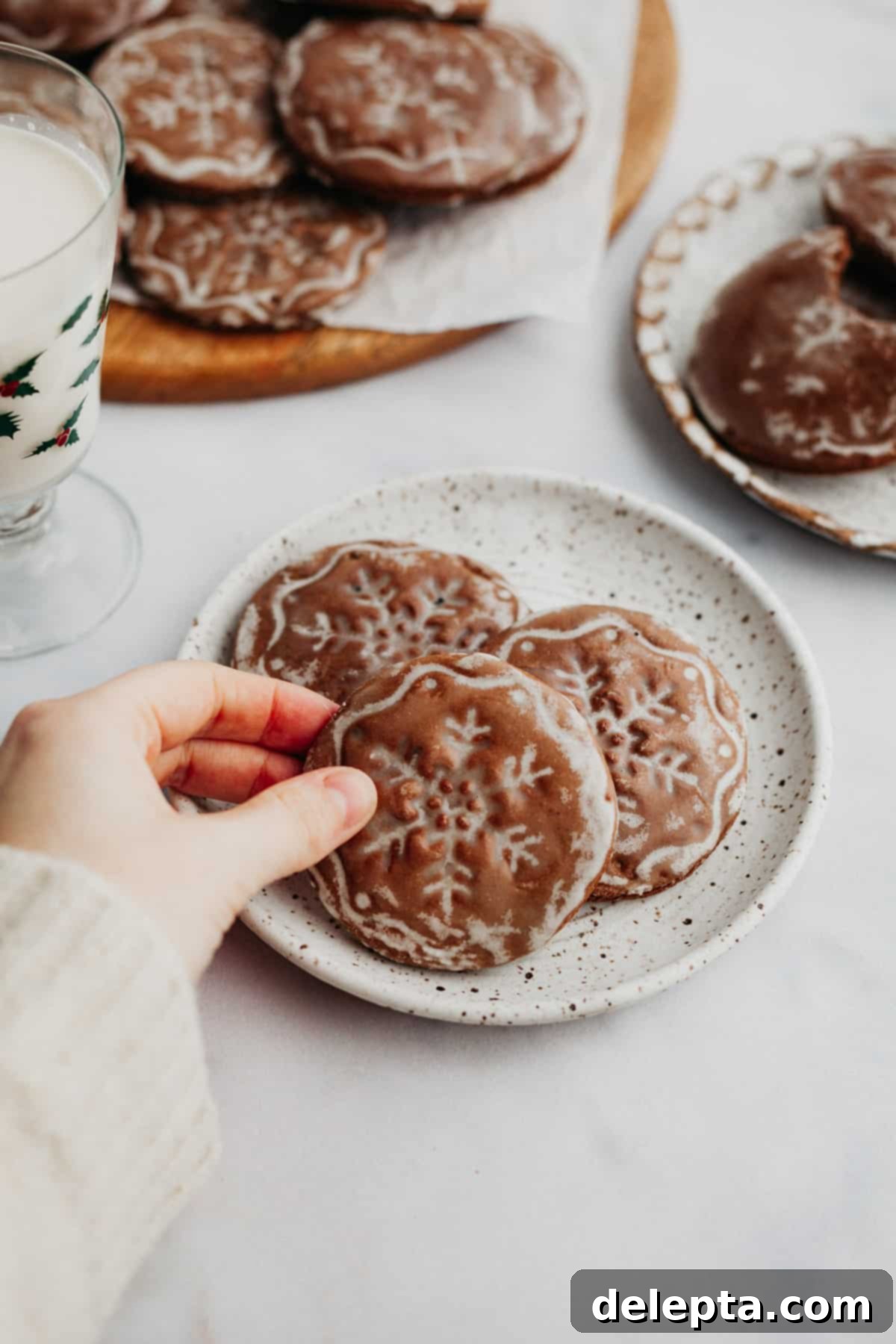
This recipe was originally published in December 2020 and has since undergone a significant update in 2022 to enhance its texture and flavor, featuring a new, improved recipe and fresh step-by-step images. Our goal was to make these beloved German gingerbread cookies even more delicious and easier to achieve perfectly every time.
These German gingerbread cookies, often referred to as Lebkuchen, are a quintessential Christmas treat, brimming with a harmonious blend of warm, aromatic spices. Beyond the classic ginger and cinnamon, this recipe introduces a touch of cocoa powder, infusing the cookies with a delightful chocolate essence. After all, who can resist a bit of chocolate goodness during the most wonderful time of the year? For those unfamiliar with Lebkuchen, imagine a wonderfully soft, moist gingerbread cookie, delicately spiced, and crowned with a sweet, thin glaze. It’s a texture and taste profile that’s distinct from crisp American-style gingerbread, offering a melt-in-your-mouth experience that is truly unforgettable.
What makes these particular Lebkuchen cookies extra special is their beautiful stamped design – a festive snowflake, perfectly capturing the spirit of winter. These intricate patterns not only make the cookies visually stunning but also add to their traditional charm. I personally sourced my snowflake cookie stamp from Birkmann, and you can easily find it here to create your own edible works of art. These Lebkuchen are undeniably among my absolute favorite Christmas cookies, embodying the warmth, flavor, and festive cheer that define the holiday season. They are sure to become a cherished part of your family’s holiday traditions too!
Looking to explore more delightful gingerbread creations this holiday season? You absolutely must try my gingerbread frosted cake for a rich, moist dessert, and my classic frosted gingerbread cookies for another timeless treat. These recipes are perfect for expanding your holiday baking repertoire!
[feast_advanced_jump_to]
What Makes These Lebkuchen So Special?
These German Gingerbread Cookies stand out for their unique flavor profile and delightful texture, making them a true holiday staple. Here’s a closer look at what makes this recipe exceptional:
- Rich Sweeteners for Depth of Flavor: The foundation of these cookies is built upon a decadent mixture of treacle, golden syrup, and brown sugar. This combination is carefully heated until it perfectly melts, creating a rich, caramel-like base that contributes significantly to the Lebkuchen’s signature depth. For those without treacle, dark molasses makes an excellent substitute, while honey can be used in place of golden syrup, offering flexibility without compromising flavor.
- A Symphony of Spices: Unlike many gingerbread recipes, ours features a truly robust and complex spice blend. We go beyond the usual ginger and cinnamon, incorporating fragrant nutmeg, warm cloves, aromatic allspice, and even a touch of black pepper. This unexpected addition of black pepper provides a subtle yet invigorating “kick” that elevates the traditional gingerbread taste, making these glazed gingerbread cookies truly memorable.
- The Essential Chilling Process: To ensure the perfect texture and prevent spreading during baking, the dough undergoes a crucial chilling period of several hours. This allows the flavors to meld beautifully and makes the dough firm enough to be easily rolled out and stamped with intricate designs, such as our festive snowflakes, ensuring crisp, defined patterns.
- Brandy Glaze for a Touch of Elegance: As soon as the cookies emerge warm from the oven, they are generously brushed with a silky-smooth brandy glaze. The warmth of the cookies helps the glaze absorb slightly, creating a beautiful sheen and locking in moisture. While brandy adds a wonderful layer of sophisticated flavor, rest assured that the glaze can be made without alcohol (using milk or water and vanilla) and will still yield equally delicious results, perfect for all to enjoy.
- Chocolatey Twist: The addition of cocoa powder gives these Lebkuchen a deep, inviting color and a subtle chocolate note that pairs exquisitely with the warm spices, setting them apart from traditional gingerbread and adding an extra layer of indulgence.
Essential Ingredients for Perfect German Gingerbread Cookies
Crafting these delectable German gingerbread cookies requires a selection of key ingredients, each playing a vital role in achieving their characteristic soft texture and rich, spiced flavor. Here’s a detailed look at what you’ll need and why:
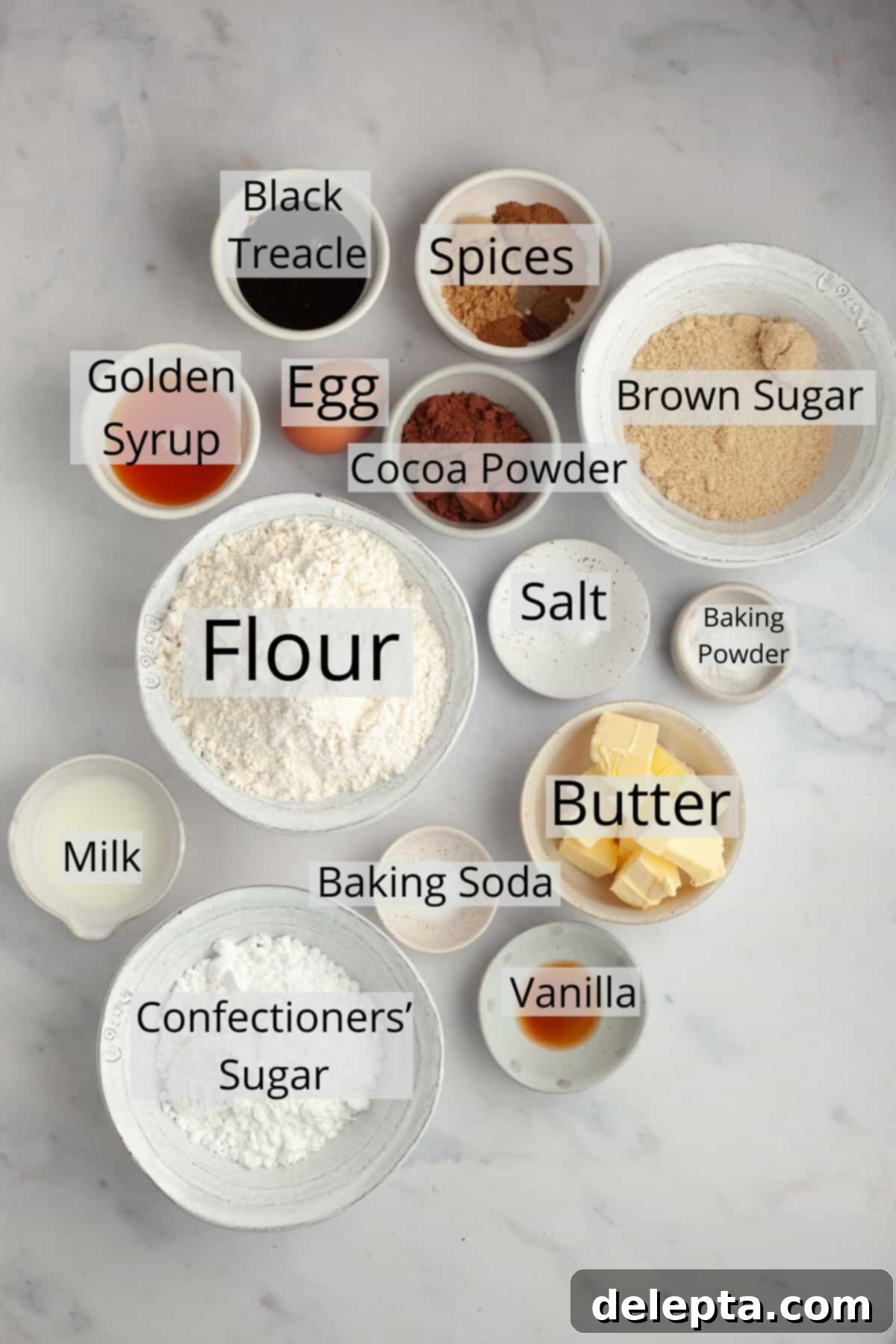
- Treacle: Black treacle is a very dark, thick, and intensely flavored syrup, similar to molasses but often with a more robust, slightly bitter note. It’s crucial for the authentic depth and color of German gingerbread. If you don’t have treacle on hand, you can confidently substitute it with dark molasses (unsulphured), which will provide a similar richness and sticky consistency essential for the dough.
- Golden Syrup: This amber-colored, invert sugar syrup is prized in British and European baking for its unique buttery, caramel flavor and smooth texture. It contributes to the soft chewiness of the gingerbread. A great substitute for golden syrup is honey, which will impart its own distinct sweetness and a lovely floral note while maintaining the desired moisture.
- Flour: This recipe has been meticulously developed and tested using standard all-purpose flour. Its balanced protein content provides the perfect structure for these soft cookies. While other flours might work, sticking to all-purpose is recommended for consistent results.
- Spices: The heart of any great gingerbread lies in its spice blend. We use a generous mix including fragrant ground cloves, warm cinnamon, sweet nutmeg, pungent ginger, aromatic allspice, and a surprising touch of black pepper. The black pepper is optional, but I highly recommend it as it adds a wonderful, subtle warmth and a “kick” that truly elevates the overall flavor profile, making the gingerbread more complex and intriguing.
- Unsalted Butter: Essential for richness and tenderizing the dough, ensuring your Lebkuchen are delightfully soft. Using unsalted butter allows you to control the overall salt content in the recipe.
- Light Brown Sugar: Adds moisture and a delicate caramel flavor to the cookies, contributing to their chewiness and depth.
- Large Egg: Acts as a binder, bringing the dough together and adding richness. Ensure it’s at room temperature for better incorporation with the other ingredients.
- Cocoa Powder: A secret ingredient for these German gingerbread cookies! It deepens the color and adds a subtle chocolate note that beautifully complements the array of spices, making these Lebkuchen even more irresistible.
- Baking Powder & Baking Soda: These leavening agents work together to give the cookies a slight lift and contribute to their soft, tender crumb.
- Kosher Salt: Balances the sweetness and enhances all the other flavors in the cookies. If using fine table salt, remember to halve the amount as it’s much denser.
- Vanilla Extract or Brandy (for the Glaze): You have a choice here! For a classic flavor, vanilla extract in the glaze is perfect. However, if you’re looking for an extra layer of warmth and sophistication, brandy or even bourbon works exceptionally well, adding a festive boozy note without being overpowering. Both options yield a delicious result.
- Confectioners’ Sugar (Icing Sugar): The base for our simple yet elegant glaze. It’s absolutely crucial to sift the powdered sugar before mixing your icing. This step ensures a lump-free, smooth, and professional-looking glaze that will beautifully highlight your stamped cookie designs.
- Milk: Used in the glaze to achieve the perfect consistency. Start with a smaller amount and add more gradually to reach your desired pourable or brushable thickness.
Step-by-Step Guide to Baking German Gingerbread Cookies
Follow these detailed instructions to create beautifully stamped and perfectly glazed German gingerbread cookies that will be the star of your holiday dessert table.
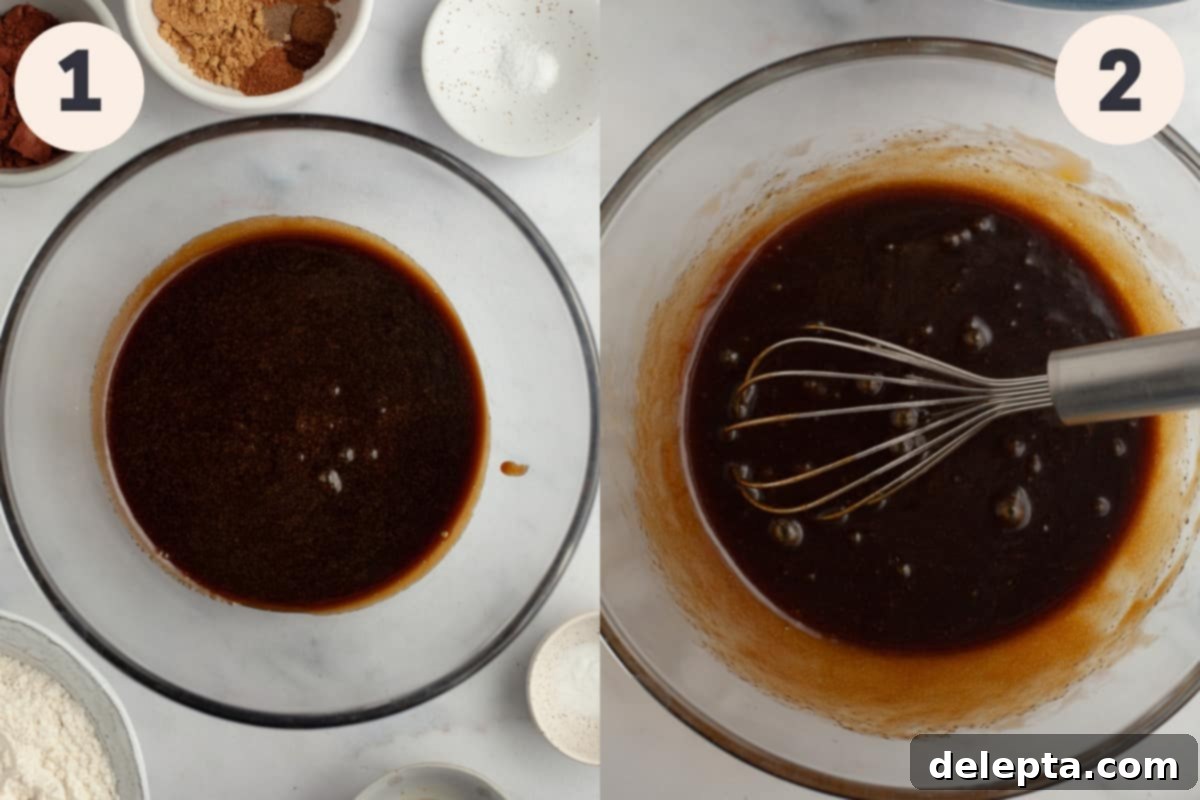
Step 1: Create the Liquid Base. In a small, heavy-bottomed saucepan, combine the light brown sugar, golden syrup, unsalted butter, and treacle. Place the saucepan over medium heat. Stir the mixture continuously until all the sugar has completely dissolved and the butter is fully melted, resulting in a smooth, homogenous liquid. This gentle heating ensures all the sugars are fully integrated, contributing to the cookie’s signature soft texture.
Step 2: Incorporate the Egg. Carefully remove the saucepan from the heat. It is crucial to let this rich mixture cool down significantly before proceeding. Once it has cooled to a lukewarm temperature (no longer hot enough to cook the egg), whisk in your room-temperature large egg until it is fully incorporated. Adding the egg when the mixture is cool prevents it from scrambling, ensuring a smooth, cohesive dough.
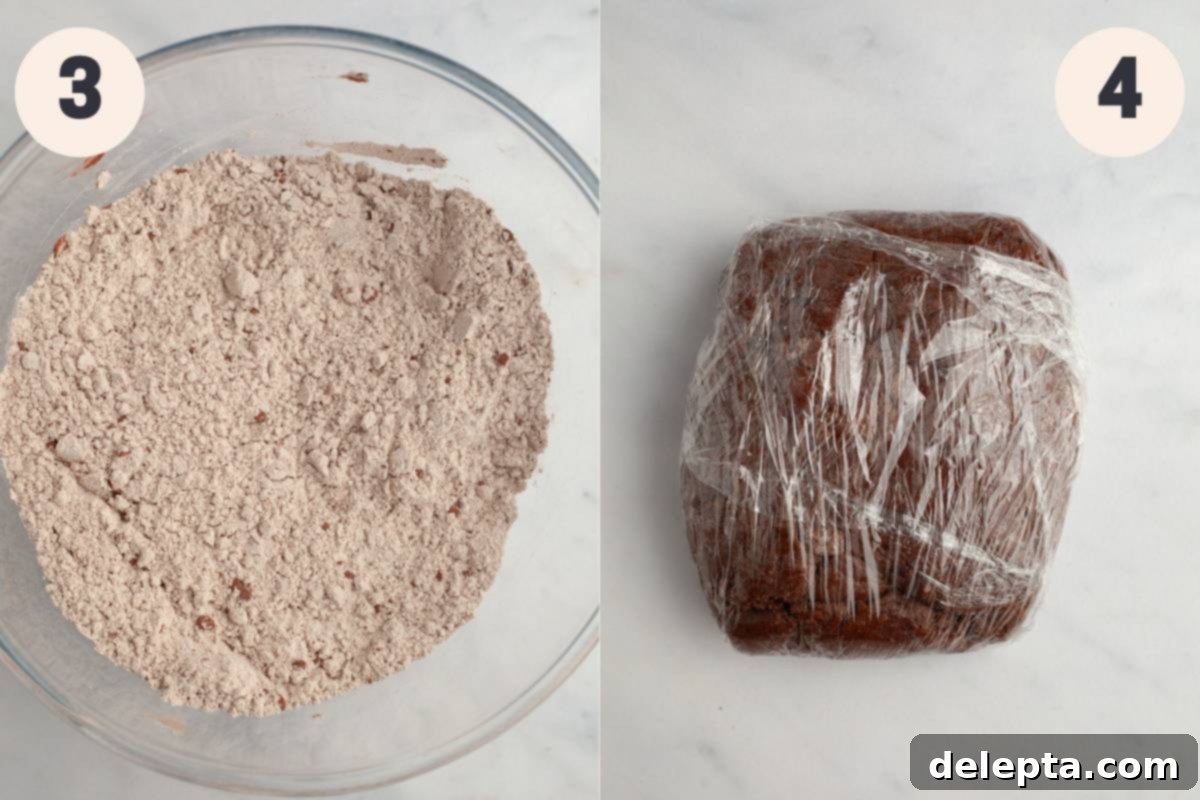
Step 3: Combine Dry Ingredients. In a large mixing bowl, thoroughly whisk together all of your dry ingredients: the all-purpose flour, cocoa powder, ground cinnamon, ground ginger, baking powder, baking soda, kosher salt, ground nutmeg, ground cloves, ground allspice, and black pepper. Whisking ensures that all the leavening agents and spices are evenly distributed, leading to uniform flavor and rise in your cookies.
Step 4: Form and Chill the Dough. Pour your cooled treacle and egg mixture into the bowl with the whisked dry ingredients. Stir initially with a spoon or spatula until the mixture is just combined and a shaggy dough begins to form. Then, use your hands to gently knead the mixture directly in the bowl or on a lightly floured surface until it all comes together into a stiff, cohesive dough. Avoid over-kneading. Once formed, shape the dough into a disc, wrap it tightly in clingfilm (plastic wrap), and place it in the refrigerator to chill for a minimum of 2 hours. This chilling period is vital; it firms up the dough, prevents spreading during baking, and allows the rich flavors to deepen.
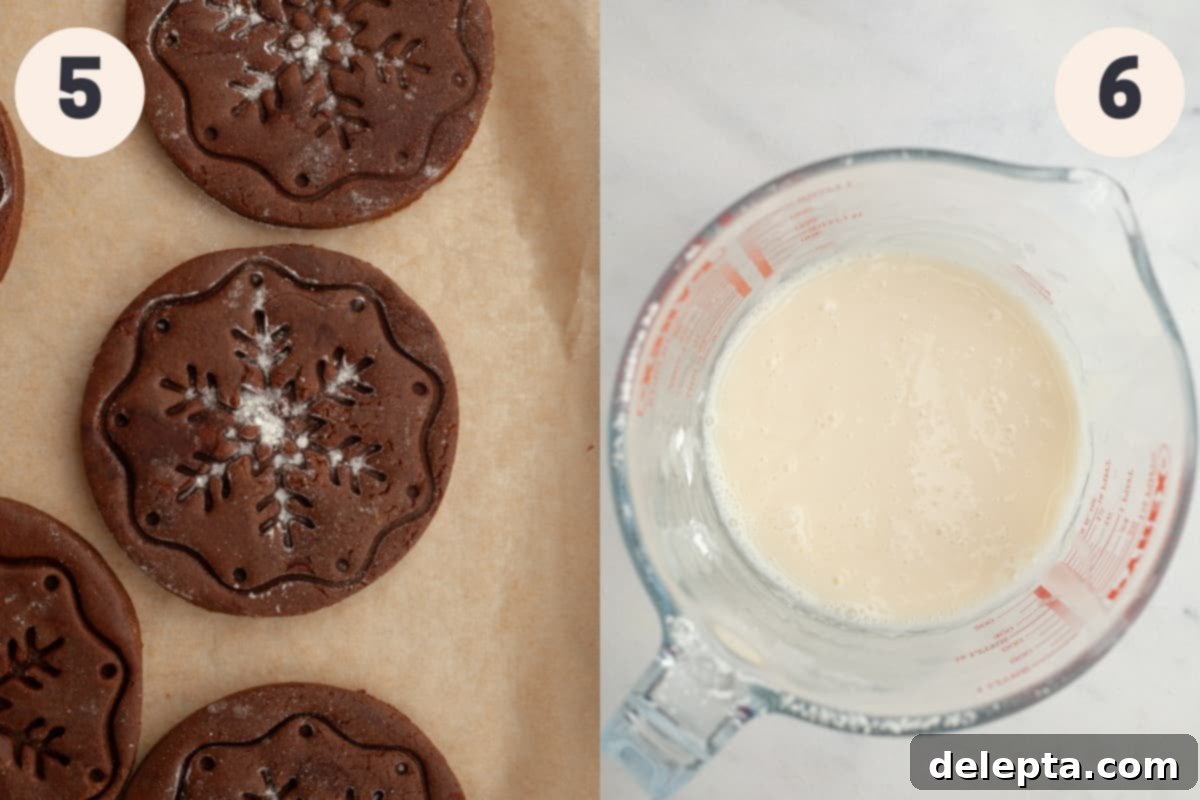
Step 5: Roll, Stamp, and Cut. Preheat your oven to 350°F (180°C) and line two large baking sheets with parchment paper. Remove the chilled dough from the fridge. If the dough feels too firm to roll, allow it to sit at room temperature for 5-10 minutes. If, however, your dough seems a bit too dry or crumbly after chilling, briefly wet your hands with a little water and knead the dough again for a minute or two until it becomes a bit softer and more pliable. On a lightly floured surface, roll out the dough evenly until it is approximately a quarter of an inch (about 6mm) thick. Now comes the fun part! Use your chosen cookie stamp to firmly emboss the dough with your desired pattern. For best results, I recommend first stamping the dough, then using a small circular cookie cutter or the rim of a mug (slightly larger than your stamp) to cut out the stamped cookies. This method ensures the stamp design is perfectly centered on each cookie. Gather any dough scraps, gently re-knead them, and re-roll to stamp and cut more cookies, minimizing waste.
Step 6: Bake and Glaze. Carefully place the cut-out, stamped cookies onto your prepared baking sheets, ensuring they are spaced about an inch apart to allow for slight spreading. Bake for 10-12 minutes, or until the edges are just set and the cookies take on a light brown color. While the cookies are baking, prepare your glaze: in a small bowl, whisk together the confectioners’ sugar, brandy (if using), vanilla extract, and 1-2 tablespoons of milk until completely smooth and free of lumps. Adjust the milk quantity as needed to achieve a brushable consistency. As soon as the cookies come out of the oven and are still warm, gently brush the tops with the prepared glaze. The warmth helps the glaze absorb and set beautifully. Don’t worry if the snowflake pattern isn’t immediately prominent; the glaze will turn completely white and the design will become much more defined after a few hours of drying.
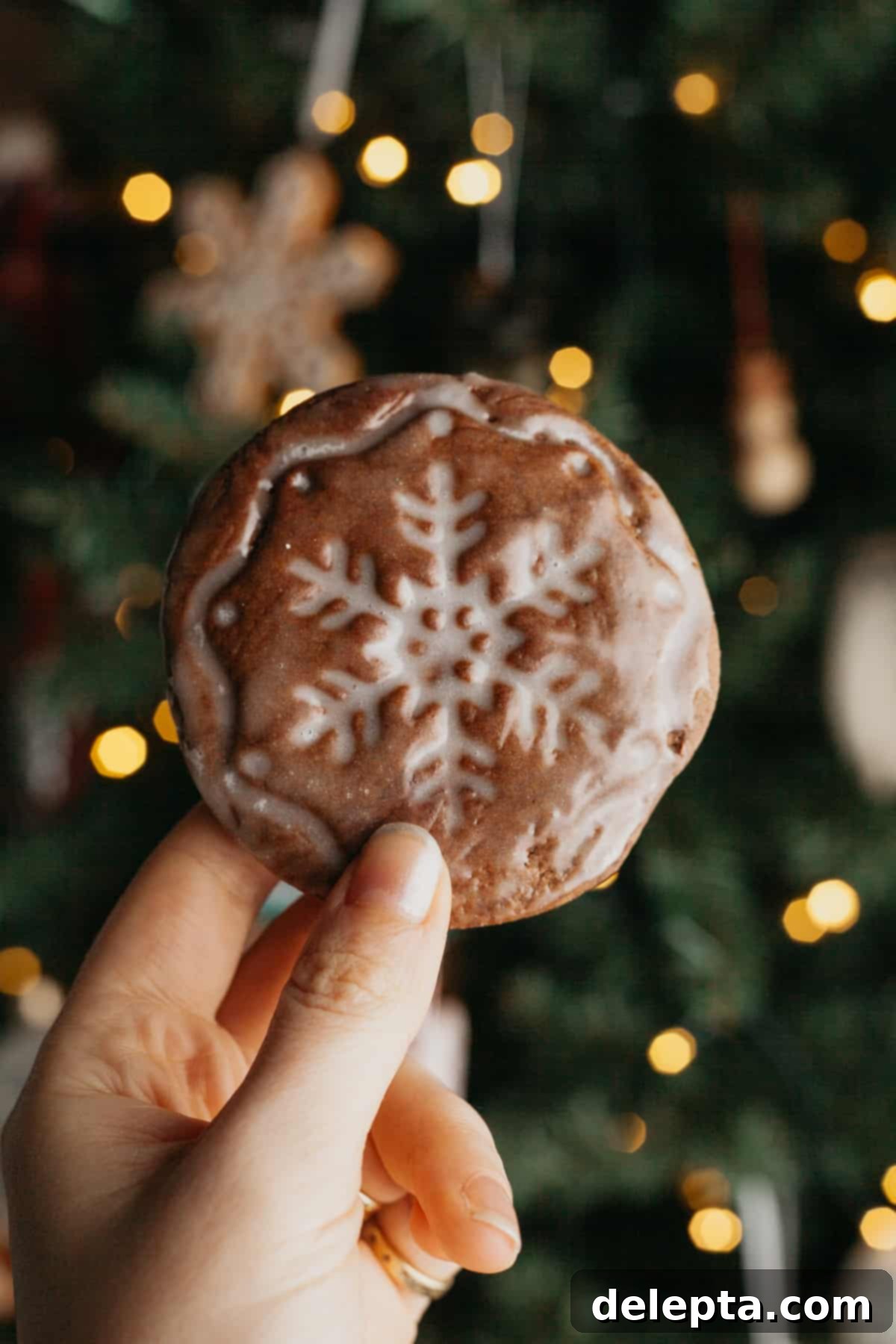
Expert Tips for Perfect German Gingerbread Cookies
Achieving bakery-quality German gingerbread cookies at home is easier than you think with these helpful tips:
- Embrace Your Kitchen Scale for Precision: For baking, especially with recipes like this that rely on specific dough consistency, I cannot stress enough the importance of using a weighing scale and measuring your ingredients using the metric system. It makes a monumental difference to the accuracy of your baking and is by far the most reliable method. Volumetric measurements (cups) can vary significantly depending on how ingredients are packed, leading to inconsistent results.
- Mastering the Stamped Cookie Technique: When working with cookie stamps, the sequence of operations is key for crisp, centered designs. I’ve discovered that the easiest and most effective way to cut out these beautiful cookies is to first firmly emboss your desired pattern onto the rolled-out dough with the cookie stamp. Then, immediately use a round cookie cutter (or even the rim of a mug) that is slightly larger than your stamp to cut out the cookie. If you try to cut the cookie first and then stamp it, the snowflake or other design isn’t always perfectly centered, and the dough can deform.
- The Art of Glazing Warm Cookies: The secret to a perfectly smooth and luminous glaze on your Lebkuchen is to brush them while they are still warm from the oven. This allows the thin glaze to slightly melt and seep into the cookie, creating a unified finish and helping to preserve moisture. Be patient after glazing; it will take some time, typically a few hours at room temperature, for the glaze to set completely and turn a crisp, opaque white. As it dries, your beautiful stamped snowflake pattern will become much more prominent and defined, making the cookies truly stunning.
- Preventing Sticky Dough: If your dough feels a bit too sticky even after chilling, try dusting your work surface and rolling pin with a mixture of flour and a tiny bit of cocoa powder. This helps maintain the dark color of the dough while preventing sticking.
- Dough Consistency is Key: If you find your dough too stiff to roll after chilling, let it sit at room temperature for about 10-15 minutes to soften slightly. If it’s too crumbly, as mentioned in the instructions, dampen your hands and knead it gently for a minute or two.
Frequently Asked Questions About German Gingerbread Cookies
Traditional German Lebkuchen, like these glazed gingerbread cookies, are intended to be wonderfully soft and tender when freshly baked. The beauty of this recipe is its delightful chewiness, which distinguishes it from many crisp gingerbread varieties. After baking, the exterior will naturally firm up slightly after a few days as moisture slowly evaporates, but the interior should remain pleasantly soft. To maintain maximum softness, proper storage is key.
Due to the rich, dark color imparted by the treacle, golden syrup, and cocoa powder, it can be a bit challenging to visually determine when these gingerbread cookies are completely baked. However, you’re looking for the edges to be just set and slightly firm to the touch, and for the cookie to have taken on a consistent light brown color (not burnt). A good indicator is when they feel slightly puffy and spring back gently when lightly pressed. They will firm up considerably as they cool. Overbaking will result in a drier, harder cookie.
To keep these delicious German gingerbread cookies (Lebkuchen) fresh and soft, store them in an airtight container at room temperature. They will maintain their quality and delightful texture for up to a week. If you wish to store them longer, they also freeze beautifully. Simply place the cooled, glazed cookies in a single layer on a baking sheet to flash freeze, then transfer them to an airtight freezer-safe bag or container for up to 2-3 months. Thaw at room temperature before serving.
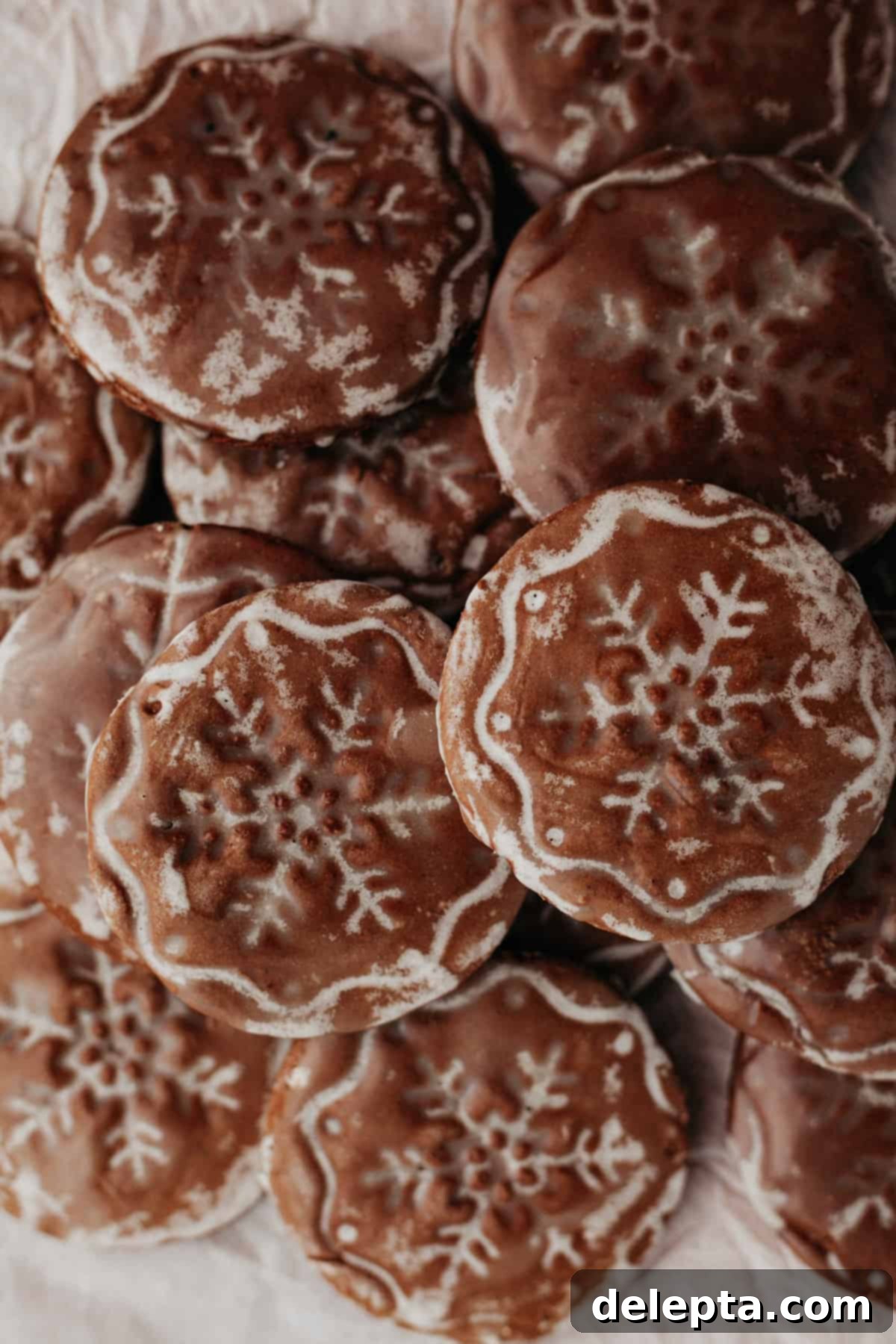
Explore More Delicious Holiday Recipes!
The festive season is a wonderful time for baking and creating sweet memories. If you enjoyed making these German Gingerbread Cookies, you’ll love these other holiday treats from my collection:
- Peppermint Bark Cookies
- Easy Cutout Shortbread Cookies
- Hot Cocoa Mug Cake
- Chocolate Tiffin
Have you tried this wonderful German Gingerbread Cookie (Lebkuchen) recipe? I would absolutely love to see your beautiful creations! Make sure to tag me on Instagram @alpineella and, if you loved them as much as I do, please leave a review below to share your experience! For even more delightful baking ideas and inspiration, you can always follow me on Pinterest. Happy baking!
Recipe
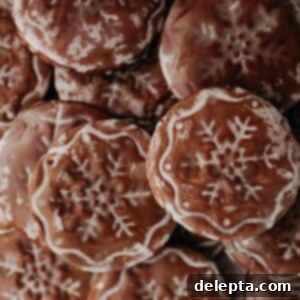
German Gingerbread Cookies (Lebkuchen)
Ella Gilbert
Pin Recipe
Save RecipeSaved!
Equipment
-
1x cookie stamp
-
Round cookie cutter (slightly larger than your stamp) or a mug
-
Small saucepan
-
Large mixing bowl
-
Whisk
-
Rolling pin
-
2 Baking sheets
-
Parchment paper
-
Pastry brush
Ingredients
Chocolate Gingerbread Dough
- 110 grams light brown sugar
- 75 grams golden syrup
- 113 grams unsalted butter
- 75 grams treacle
- 1 large egg room temperature
- 315 grams all-purpose flour
- 30 grams cocoa powder
- 2 teaspoons ground cinnamon
- 2 teaspoons ground ginger
- 1 teaspoon baking powder
- ½ teaspoon baking soda
- ¼ teaspoon kosher salt
- ¼ teaspoon ground nutmeg
- ⅛ teaspoon ground cloves
- ⅛ teaspoon ground allspice
- ⅛ teaspoon black pepper
Simple Glaze
- 120 grams icing sugar sifted
- 2 tablespoons brandy (optional, or use more milk)
- 1 teaspoon vanilla extract
- 1-2 tablespoons milk (adjust for consistency)
Instructions
-
In a small saucepan, gently heat the light brown sugar, golden syrup, unsalted butter, and treacle over medium heat. Stir continuously until the sugar is fully dissolved and the mixture is smooth. Remove from heat and allow the mixture to cool down completely to lukewarm. Once cooled, add the room temperature egg and whisk until well combined and smooth.110 grams light brown sugar, 75 grams golden syrup, 113 grams unsalted butter, 75 grams treacle, 1 large egg
-
In a large bowl, whisk together the all-purpose flour, cocoa powder, ground cinnamon, ground ginger, baking powder, baking soda, kosher salt, ground nutmeg, ground cloves, ground allspice, and black pepper until thoroughly combined. Pour the cooled sugar-syrup mixture into the dry ingredients and stir with a spoon until just combined and a shaggy dough forms. Transfer the mixture onto a lightly floured surface and knead gently with your hands until the dough comes together and is stiff but smooth. Shape the dough into a flat disc, wrap it tightly in plastic wrap, and refrigerate for a minimum of 2 hours.315 grams all-purpose flour, 30 grams cocoa powder, 2 teaspoons ground cinnamon, 2 teaspoons ground ginger, 1 teaspoon baking powder, ¼ teaspoon kosher salt, ¼ teaspoon ground nutmeg, ⅛ teaspoon ground cloves, ⅛ teaspoon ground allspice, ⅛ teaspoon black pepper, ½ teaspoon baking soda
-
Preheat your oven to 350°F (180°C). Line two large baking sheets with parchment paper for easy release.
-
Remove the chilled dough from the fridge. On a lightly floured surface, roll out the dough evenly until it is approximately ¼ inch (6mm) thick. If the dough is too dry or difficult to roll, lightly dampen your hands with water and briefly knead it again until it becomes softer and more pliable.
-
Using your chosen cookie stamp, firmly press it into the rolled-out dough to emboss the design. For best results, use a round cookie cutter (or the rim of a mug) that is slightly larger than your stamp to cut out the cookies, ensuring the design is centered. Carefully transfer the stamped and cut cookies to the prepared baking sheets, spacing them 1-2 inches apart. Collect any dough scraps, gently re-knead them, re-roll, and cut additional cookies until all dough is used.
-
Bake the cookies for 10-12 minutes, or until the edges are lightly set and the cookies have a consistent light golden brown color. They will firm up further as they cool.
-
While the cookies are still warm from the oven, prepare the glaze. In a small bowl, whisk together the sifted icing sugar, 1-2 tablespoons of milk, brandy (if using), and vanilla extract until completely smooth and free of lumps. The consistency should be thin enough to brush, but not watery. Using a pastry brush, gently brush the still-warm cookies with the glaze. Let the cookies cool completely on a wire rack for several hours until the glaze has set and turned opaque, allowing the stamped pattern to become prominent.120 grams icing sugar, 2 tablespoons brandy, 1 teaspoon vanilla extract, 1-2 tablespoons milk
Video
Notes
Original Recipe Update: This recipe has been significantly updated as of 2022 to improve the dough’s workability and the cookies’ final texture. For those who might prefer the original version, simply omit the ½ cup (approximately 113 grams) of unsalted butter from the dough ingredients. Both methods yield delicious results, but the added butter, melted with the other wet ingredients, helps ensure a softer, more pliable dough that is easier to roll out and less prone to being too dry.
Treacle Substitute: If black treacle is difficult to find in your local grocery store, you can successfully substitute it with an equal amount of dark molasses. Both provide a deep, rich, and slightly bitter sweetness that is characteristic of authentic Lebkuchen.
Salt Usage: If you do not have kosher salt on hand, please halve the amount of salt specified in the recipe. As a general guideline, 1 teaspoon of Diamond Crystal kosher salt is roughly equivalent to ½ teaspoon of fine table salt. It’s important to note that I specifically use Diamond Crystal kosher salt in my recipes, which is less potent than Morton salt; using Morton salt in the same quantity as Diamond Crystal would make your bake far too salty.
Golden Syrup Substitute: Should you not have golden syrup, a good alternative is to use an equal amount of runny honey. The flavor profile will shift slightly, but the honey will provide a similar moisture content and sweetness to keep the cookies tender and delicious.
Storage Instructions: Once cooled and the glaze is fully set, store your German gingerbread cookies in an airtight container at room temperature. They will remain wonderfully fresh and soft for up to a week, making them perfect for preparing in advance for holiday festivities.
Nutrition
